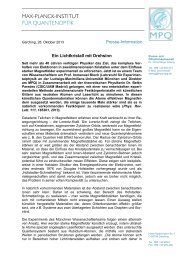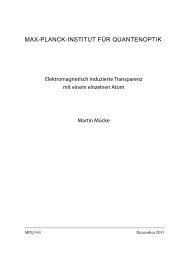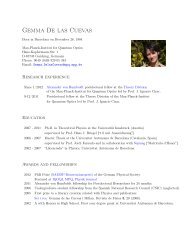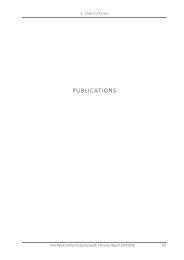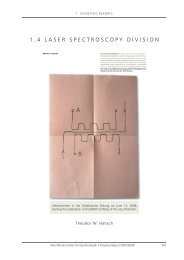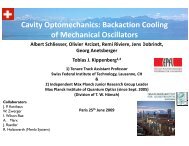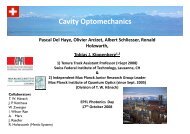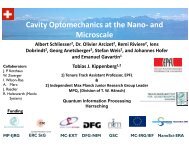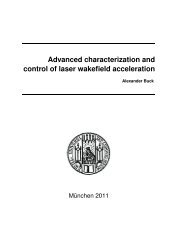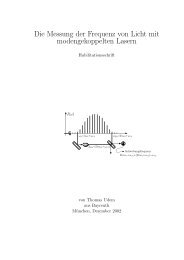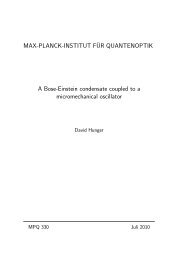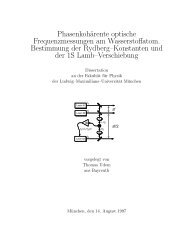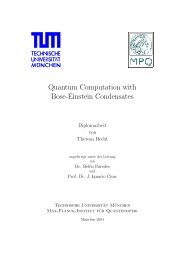Attosecond Control and Measurement: Lightwave Electronics
Attosecond Control and Measurement: Lightwave Electronics
Attosecond Control and Measurement: Lightwave Electronics
You also want an ePaper? Increase the reach of your titles
YUMPU automatically turns print PDFs into web optimized ePapers that Google loves.
1 . 3 AT T O S E C O N D A N D H I G H - F I E L D P H Y S I C S D I V I S I O N<br />
electrons <strong>and</strong> ions) for a range of applications<br />
in physics <strong>and</strong> life sciences.<br />
Each of these areas builds upon strong synergies<br />
between theoretical <strong>and</strong> experimental research <strong>and</strong> is<br />
based on a number of collaborations with groups from<br />
all over the world. The facilities of our LMU-MPQ joint<br />
laboratory are situated at MPQ <strong>and</strong> the LMU Physics<br />
Building at Coulombwall 1. LAP members working at<br />
both locations closely co-operate, forming a single<br />
coherent group with weekly meetings, discussions <strong>and</strong><br />
intense communications on a daily basis.<br />
1.3.1.1 PUShING ThE FRONTIERS OF FEMTOSECOND<br />
TEChNOlOGY<br />
<strong>Attosecond</strong> technology is based upon <strong>and</strong> has grown<br />
out of femtosecond technology. Improving femtosecond<br />
technology towards<br />
(i) b<strong>and</strong>widths approaching, reaching, <strong>and</strong><br />
exceeding an octave,<br />
(ii) intense pulses at higher (MHz) repetition<br />
rates, i.e. higher average powers,<br />
(iii) higher peak powers both at kilohertz as<br />
well as 10 Hertz repetition rates<br />
<strong>and</strong> endowing it with<br />
(iv) carrier-envelope phase stabilization<br />
constitute basic requirements for advancing attosecond<br />
technology.<br />
Advances (i) <strong>and</strong> (iv) enable researches to generate<br />
intense laser pulses with stabilized waveform. Strongfield<br />
(multi-photon-assisted) interaction of these<br />
waveform-stabilized pulses with matter has provided<br />
access to the value of their carrier-envelope phase<br />
[3], allowing the determination <strong>and</strong> thereby full<br />
control of their waveform. We dub the sources of<br />
these waveform-controlled few-cycle light pulses light<br />
waveform synthesizers <strong>and</strong> consider them as the major<br />
technological pillars of attosecond science. Increasing<br />
their b<strong>and</strong>width (i) improves attosecond metrology<br />
by generating shorter isolated attosecond pulses with<br />
higher efficiency (see next chapter). Increasing their<br />
pulse repetition rate into the MHz regime (ii) opens<br />
the door for endowing coincidence spectroscopy with<br />
attosecond temporal resolution. Last but not least,<br />
increasing their peak power to the multi-terawatt<br />
regime (iii) is the prerequisite for extending attosecond<br />
control to relativistic electrons.<br />
BROADBAND ChIRPED DIElECTRIC MUlTIlAYER<br />
MIRRORS<br />
constitute an enabling technology for all these<br />
developments: they are the only optical components<br />
capable of providing dispersion control<br />
(i) over b<strong>and</strong>widths required for shaping optical<br />
waveforms within the wave cycle,<br />
(ii) with extremely low loss required for high-averagepower<br />
MHz-rate femtosecond pulse generation<br />
in high-Q laser resonators <strong>and</strong> passive build-up<br />
cavities,<br />
(iii) with low amount of material withst<strong>and</strong>ing high<br />
intensities, making them ideal for tailoring,<br />
steering <strong>and</strong> focusing ultrabroad-b<strong>and</strong>, multiterawatt<br />
pulses.<br />
Therefore we continue – even some 15 years after its<br />
invention [18] – our efforts to advance this technology.<br />
In collaboration with A. V. Tikhonravov <strong>and</strong> M. K.<br />
Trubestkov from Moscow State University, Vladimir<br />
Pervak <strong>and</strong> Alex<strong>and</strong>er Apolonskiy have developed a<br />
family of dispersive mirrors for precision dispersion<br />
control over an octave or more in the visible (VIS), nearinfrared<br />
(NIR) spectral range for widespread use in LAP’s<br />
ultrafast laser “workhorses” (see next section).<br />
With MAP Service Center’s newly-installed electron-beam<br />
evaporation system, the team has recently succeeded<br />
in the first realization of a chirped multilayer dielectric<br />
mirror providing dispersion control over the spectral<br />
range of 300-900 nm <strong>and</strong> the first use of hafnium oxide<br />
in a chirped mirror [19]. Simultaneously, the chirped<br />
mirror technology is being extended to the mid IR<br />
(MIR) up to wavelengths of 3 μm. Precision dispersion<br />
metrology via white light interferometry is also being<br />
extended to the same spectral range (from MIR to UV).<br />
These developments allow extension of broadb<strong>and</strong><br />
dispersion control to a spectral range spanning several<br />
octaves, paving the way towards the generation<br />
of mono-cycle to sub-cycle optical waveforms <strong>and</strong><br />
arbitrary optical waveform synthesis, as well as towards<br />
frequency combs over the UV-VIS-NIR-MIR spectral<br />
range. Moreover, hafnium-oxide-based chirped mirrors<br />
will lead to high-damage-threshold broadb<strong>and</strong> optics<br />
for high-power applications.<br />
lIGhT WAVEFORM SYNThESIZERS<br />
constitute key tools for attosecond science. Thanks to<br />
ongoing advances in chirped multilayer technology, we<br />
can now reliably generate intense (sub-terawatt) sub-<br />
1.5-cycle laser pulses in the VIS/NIR spectral range at<br />
kHz repetition rates in several workhorse laser systems<br />
on a daily basis in our laboratory. Figure 1 shows the<br />
spectrum <strong>and</strong> interferometric autocorrelation recorded<br />
by Adrian Cavalieri <strong>and</strong> coworkers, featuring clean, ~3.5fs-duration<br />
(full width at half maximum) laser pulses<br />
carried at a wavelength of ~ 750 nm (field oscillation<br />
period ~ 2.5 fs) [6,20]. This performance has recently<br />
been reproduced by Sergei Trushin, Izhar Ahmad <strong>and</strong><br />
co-workers, <strong>and</strong> by Eleftherios Goulielmakis <strong>and</strong> Martin<br />
Schultze using other LAP laser systems, demonstrating<br />
134 Max-Planck-Institut für Quantenoptik • Progress Report 2007/2008



